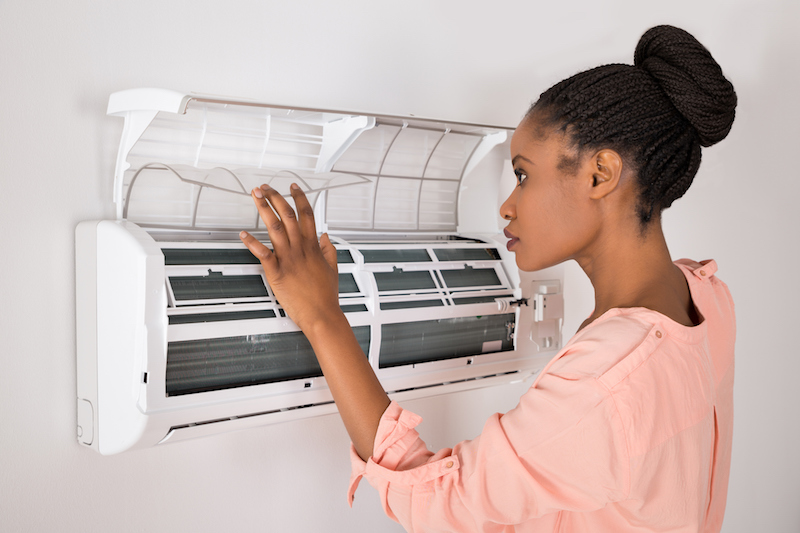
You shouldn’t be forced to give up comfort or drain your wallet to keep your house at a refreshing setting during warm days.
But what is the ideal temp, exactly? We discuss ideas from energy experts so you can select the best temperature for your house.
Here’s what we recommend for the most energy-efficient setting for air conditioning in Michigan City.
Recommended Thermostat Settings for Summer
Most households find placing the thermostat at 72-73 degrees is most comfortable. However, if there’s a big difference between your inside and outdoor temps, your electrical bills will be larger.
These are our recommendations based on the U.S. Department of Energy (DOE) and ENERGY STAR®.
While at home: 78 degrees. While that appears hot, there are methods you can keep your home pleasant without having the air conditioner running frequently.
Keeping windows and window treatments down during the day keeps cold air where it should be—inside. Some window solutions, like honeycomb shades or plantation shutters, are made to deliver added insulation and improved energy efficiency.
If you have ceiling fans in your residence, the DOE says you can raise thermostat settings about 4 degrees higher without compromising comfort. That’s since they refresh with a windchill effect. As they cool people, not rooms, shut them off when you exit a room.
If 78 degrees still feels too hot initially, try conducting a trial for a week or so. Start by increasing your thermostat to 78 degrees while you’re at your house. Then, progressively decrease it while adhering to the suggestions above. You might be surprised at how comfortable you feel at a hotter temperature setting.
While away: 88 degrees. There’s no reason to keep the air conditioner going all day while your home is unoccupied. Turning the temperature 7–10 degrees higher can save you anywhere from 5–15% on your air conditioning expenses, according to the DOE.
When you come home, don’t be tempted to set your thermostat below 78 to cool your house more quickly. This isn’t useful and usually produces a more expensive AC cost.
A programmable thermostat is a useful approach to keep your temperature in check, but you need to set programs. If you don’t set programs, you might forget to increase the set temperature when you leave.
If you need a handy remedy, think over buying a smart thermostat. This thermostat links with your phone, so it is aware when you’re at your house and when you’re gone. Then it automatically adjusts temperature settings for the best savings. How much exactly? Typically $180 yearly on heating and cooling, according to ENERGY STAR.
Another perk of getting a smart thermostat? You can use your phone to keep an eye on and regulate temperature settings from nearly anywhere.
While sleeping: Around 70 degrees. While ENERGY STAR recommends 82 degrees, that may be unpleasant for most families. Most people sleep better when their bedroom is chilly, so that’s why the National Sleep Foundation suggests 60–67 degrees. But that could be too cold, based on your PJ and blanket preference.
We recommend following a similar test over a week, setting your temperature higher and steadily turning it down to pick the best temp for your family. On pleasant nights, you could find keeping windows open at night and relying on a ceiling fan is a preferable idea than running the air conditioner.
More Approaches to Use Less Energy This Summer
There are additional methods you can conserve money on utility bills throughout the summer.
- Upgrade to an energy-efficient cooling system. Central air conditioners only last about 12–15 years and lose efficiency as they get older. An updated air conditioner can keep your home cooler while keeping AC bills low.
- Schedule yearly air conditioner tune-ups. Routine air conditioner maintenance keeps your equipment operating properly and may help it work at better efficiency. It could also help prolong its life expectancy, since it enables technicians to discover little troubles before they cause a major meltdown.
- Replace air filters often. Use manufacturer instructions for replacing your air filter. A dirty filter can lead to your system short cycling, or switch on and off too frequently, and drive up your electrical.
- Inspect attic insulation levels. Just about 90% of residences in the U.S. don’t have proper insulation, according to the Insulation Institute. Most southern climates need 13–14” of attic insulation, while northern climates need 16–18”.
- Have your ductwork checked. Ductwork that has loosened over time can leak cool air into your attic, walls or crawl space. This can lead to big comfort troubles in your home, including hot and cold spots.
- Seal holes, doors and windows. Keep humid air where it belongs by closing openings. You can also caulk or weather strip doors to keep more cool air inside.
Conserve More Energy During Warm Weather with Paniccia Heating & Cooling
If you are looking to save more energy during hot weather, our Paniccia Heating & Cooling professionals can help. Get in touch with us at 219-872-2198 or contact us online for additional info about our energy-saving cooling products.
